Top 10 animals to spot in Costa Rica
Costa Rica is bursting with nature and beauty – in fact it’s one of the most biodiverse corners of the globe. The small country in Central America is undoubtedly one of the best places to visit if you want guaranteed wildlife encounters of all sorts. The beauty of it is that you don’t necessarily have to go far to find them, many people simply walk out of their hotel and come face to face with fascinating creatures of all sorts. There are more than 500,000 species of plant and animal existing in Costa Rica – quite a feat considering the country is a mere 51,000 kilometres squared. An incredible 25% of Costa Rica is protected land, providing sanctuary to the various flora and fauna that exist here, and within that you can find 28 national parks, 58 wildlife refuges, 32 protected zones, 15 wetland areas, 11 forests and 8 biological reserves. If you’re ready to visit the land where 5% of the world’s biodiversity call home, then look no further than Costa Rica. Here are just a few of the animals that you can expect to find.
Sloths
Sloths have become somewhat of a popular animal in recent years, with people appreciating and humouring their slow and lazy pace of life. The cute creature has subsequently become a symbol of Costa Rica, with its “pura vida” outlook on life mirroring the country itself. The sloth (both the two-toed and three-toes varieties thrive in Costa Rica) lives up in the treetops and are one of the easiest animals to spot. Everything about their movement is slow, including their digestive system. Our guide told us they leave their trees around once a week to head to the bathroom – imagine that! Their long, sharp claws allow them to cling to trees and swipe away any predators. But contrary to belief sloths don’t sleep all day. They still spend an average of 8 to 10 hours snoozing, but the rest of the day is spent moving perpetually slowly in search of food. You can quite easily spot them in Manuel Antonio National Park and Tortuguero National Park, but keep an eye on the trees wherever you are and you’re likely to spot one or two in the distance. It’s also quite common to spot them in treetops when you are travelling between destinations.
 Toucan
Toucans are some of the oddest looking birds on the planet. With their giant curved beaks and relatively small body size, you might think they will topple off the trees. Costa Rica is home to six species of toucans, including the keel-billed variety which are what most people might think of when they picture the unusual bird. With their brightly coloured bills and necks, they stand out against the rainforest landscape and are relatively easy to spot in the rainforests, even from a distance. They are found throughout Costa Rica, but are smaller in size than most people expect so if you want some really great photographs, ensure your camera has a decent lense and zoom. Toucans are omnivores, which means they mainly eat tropical fruit, seeds, berries and insects. They can also be quite social animals and normally live in small flocks of between five and seven members, and while you might see them flying all over the place in Costa Rica, they don’t migrate and live in tropical climes throughout the year.
Toucan
Toucans are some of the oddest looking birds on the planet. With their giant curved beaks and relatively small body size, you might think they will topple off the trees. Costa Rica is home to six species of toucans, including the keel-billed variety which are what most people might think of when they picture the unusual bird. With their brightly coloured bills and necks, they stand out against the rainforest landscape and are relatively easy to spot in the rainforests, even from a distance. They are found throughout Costa Rica, but are smaller in size than most people expect so if you want some really great photographs, ensure your camera has a decent lense and zoom. Toucans are omnivores, which means they mainly eat tropical fruit, seeds, berries and insects. They can also be quite social animals and normally live in small flocks of between five and seven members, and while you might see them flying all over the place in Costa Rica, they don’t migrate and live in tropical climes throughout the year.
 Howler Monkey
Chances are you will hear them before you see them – these feisty creatures are known for their loud howls and screams, which can be heard from up to 3 miles away. They are most commonly seen in Arenal Volcano National Park but can also be spotted in rainforests around the country. The howler monkeys are quite large in size and are covered in black fur making them distinct to many of the other monkeys found in Costa Rica. If you want to spot them, you’ll have to look up! They often build nests high in the trees and are unlikely to be seen on the ground, except when they have spied some tasty treats to snack on.
Howler Monkey
Chances are you will hear them before you see them – these feisty creatures are known for their loud howls and screams, which can be heard from up to 3 miles away. They are most commonly seen in Arenal Volcano National Park but can also be spotted in rainforests around the country. The howler monkeys are quite large in size and are covered in black fur making them distinct to many of the other monkeys found in Costa Rica. If you want to spot them, you’ll have to look up! They often build nests high in the trees and are unlikely to be seen on the ground, except when they have spied some tasty treats to snack on.
 White-faced Capuchin Monkey
These cute creatures are also known as just the white-faced monkey and are commonly found in many of the national parks in Costa Rica, including Monteverde Cloud Forest and Manuel Antonio National Park. They are used to visitors and have no problem getting up close to you, often scurrying past your legs! They are also frequently spotted near the beaches in Manuel Antonio, so if you go for a dip we recommend watching your belongings or you might spot one of these cheeky animals taking off with your sunglasses.They are aptly named after their furry white face, which stands out against the rest of their black furry body. They mostly spend their days jumping between trees and foraging for food – mainly insects and plants. They are known for their excellent jumping skills so if you spot one, hang around to catch a glimpse of the distance they reach – it’s often up to nine feet! The Capuchin monkey lives in groups which can be up to 40 members, typically led by an alpha leader from each gender.
White-faced Capuchin Monkey
These cute creatures are also known as just the white-faced monkey and are commonly found in many of the national parks in Costa Rica, including Monteverde Cloud Forest and Manuel Antonio National Park. They are used to visitors and have no problem getting up close to you, often scurrying past your legs! They are also frequently spotted near the beaches in Manuel Antonio, so if you go for a dip we recommend watching your belongings or you might spot one of these cheeky animals taking off with your sunglasses.They are aptly named after their furry white face, which stands out against the rest of their black furry body. They mostly spend their days jumping between trees and foraging for food – mainly insects and plants. They are known for their excellent jumping skills so if you spot one, hang around to catch a glimpse of the distance they reach – it’s often up to nine feet! The Capuchin monkey lives in groups which can be up to 40 members, typically led by an alpha leader from each gender.
 Red eyed tree frog
This brightly coloured amphibian is often plastered over Costa Rican wildlife brochures. They live in humid lowlands, often near rivers and ponds which makes the steamy Costa Rican rainforest the perfect home for these small yet vibrant creatures. The red-eyed tree frog has adapted perfectly to keep itself safe from the many predators in the county. Remaining motionless for a large part of the day, they will open their eyes wide and spread their toes to show off their startling colours. This shocks predators and gives the frog enough time to jump to safety. While they are found all over Central America, they are most prominent in Costa Rica and can often be seen in Monteverde Cloud Forest, Tortuguero National Park and Manuel Antonio National Park. They can be more difficult to spot because of their size and you’ll want a decent camera for when you are lucky enough to see one!
Red eyed tree frog
This brightly coloured amphibian is often plastered over Costa Rican wildlife brochures. They live in humid lowlands, often near rivers and ponds which makes the steamy Costa Rican rainforest the perfect home for these small yet vibrant creatures. The red-eyed tree frog has adapted perfectly to keep itself safe from the many predators in the county. Remaining motionless for a large part of the day, they will open their eyes wide and spread their toes to show off their startling colours. This shocks predators and gives the frog enough time to jump to safety. While they are found all over Central America, they are most prominent in Costa Rica and can often be seen in Monteverde Cloud Forest, Tortuguero National Park and Manuel Antonio National Park. They can be more difficult to spot because of their size and you’ll want a decent camera for when you are lucky enough to see one!
 Scarlet Macaw
Native to Costa Rica, Scarlet Macaws make for the perfect wildlife photo, with their rainbow-style bright feathers contrasting against the lush green background of the rainforest. They are considered one of the most beautiful types of parrot and are often used in imagery on wildlife due to their colourful exterior. The Scarlet Macaw was once almost extinct in Costa Rica, but conservation efforts have paid off and the birds have made a great recovery, with numbers currently hovering at around 1,500. Luckily for travellers, their brightly coloured feathers don’t blend into the natural environment so they are pretty easy to spot if you’re around the right location. They can be found along the Central Pacific Coast in Costa Rica but most notably in Manuel Antonio National Park, Carara National Park and Pal Verde National Park.
Scarlet Macaw
Native to Costa Rica, Scarlet Macaws make for the perfect wildlife photo, with their rainbow-style bright feathers contrasting against the lush green background of the rainforest. They are considered one of the most beautiful types of parrot and are often used in imagery on wildlife due to their colourful exterior. The Scarlet Macaw was once almost extinct in Costa Rica, but conservation efforts have paid off and the birds have made a great recovery, with numbers currently hovering at around 1,500. Luckily for travellers, their brightly coloured feathers don’t blend into the natural environment so they are pretty easy to spot if you’re around the right location. They can be found along the Central Pacific Coast in Costa Rica but most notably in Manuel Antonio National Park, Carara National Park and Pal Verde National Park.
 Hummingbirds
If you find yourself close to water, look out for colourful plants or flowers and you might be lucky enough to spot an equally colourful hummingbird feeding on the nectar. These small yet beautiful birds, with fluorescent feathers of green, blue and purple shades, are commonly seen in La Fortuna and Monteverde but can be spotted anywhere in Costa Rica that is close to water. The tropical country is home to around 50 types of hummingbird, with two of them being endemic to Costa Rica itself. These are the mangrove hummingbird and the coppery-headed emerald hummingbird, both with their beautifully distinctive exterior. Hummingbirds are the smallest species of bird in the world, so if you are looking for some great pictures, ensure you travel with a decent camera.
Hummingbirds
If you find yourself close to water, look out for colourful plants or flowers and you might be lucky enough to spot an equally colourful hummingbird feeding on the nectar. These small yet beautiful birds, with fluorescent feathers of green, blue and purple shades, are commonly seen in La Fortuna and Monteverde but can be spotted anywhere in Costa Rica that is close to water. The tropical country is home to around 50 types of hummingbird, with two of them being endemic to Costa Rica itself. These are the mangrove hummingbird and the coppery-headed emerald hummingbird, both with their beautifully distinctive exterior. Hummingbirds are the smallest species of bird in the world, so if you are looking for some great pictures, ensure you travel with a decent camera.
 Crocodiles & Caiman
Costa Rica is home to a large population of crocodiles and caiman. Interestingly, the prehistoric looking creatures have a high tolerance to salt water and so it’s not unusual to spot them on the beaches of Costa Rica too. However, they prefer to live in rivers, swamps and lagoons and will spend most of their time on the shore warming up in the sun before lurking in the water in search of prey. For those who want the best chance at seeing them, head to Tarcoles River Bridge where hundreds roam below. You’ll often spot caiman lurking in the rivers and swamps of the national parks, waiting patiently on smaller prey along the riverbanks.
Crocodiles & Caiman
Costa Rica is home to a large population of crocodiles and caiman. Interestingly, the prehistoric looking creatures have a high tolerance to salt water and so it’s not unusual to spot them on the beaches of Costa Rica too. However, they prefer to live in rivers, swamps and lagoons and will spend most of their time on the shore warming up in the sun before lurking in the water in search of prey. For those who want the best chance at seeing them, head to Tarcoles River Bridge where hundreds roam below. You’ll often spot caiman lurking in the rivers and swamps of the national parks, waiting patiently on smaller prey along the riverbanks.
 Spider Monkeys
Spider Monkeys are one of the most common animals you’ll see throughout Costa Rica. These highly social animals are named after their appearance – they have oddly long limbs and a long tail, making them very limber as they swing through the rainforest. You’ll commonly see them swinging between branches and searching for fruit and insects, occasionally dropping to the forest floor if they spot something tasty. Like many other species of mischievous monkeys, they are known to be quite vocal and will often let out a toe-curling scream if they sense any danger.
Spider Monkeys
Spider Monkeys are one of the most common animals you’ll see throughout Costa Rica. These highly social animals are named after their appearance – they have oddly long limbs and a long tail, making them very limber as they swing through the rainforest. You’ll commonly see them swinging between branches and searching for fruit and insects, occasionally dropping to the forest floor if they spot something tasty. Like many other species of mischievous monkeys, they are known to be quite vocal and will often let out a toe-curling scream if they sense any danger.
 Blue Morpho Butterfly
When you’re walking through the hot and humid rainforests of Costa Rica, in search of toucans, monkeys, sloths and more, it can be easy to forget about the smaller residents of the jungle. Although small it is, the Blue Morpho Butterfly is among the largest of its species in the world with a wingspan of between five and eight inches. When you catch a glimpse of one, it really is a beautiful sight, with its neon blue wings fluttering around you. They are harder to spot than the other wildlife but can be found throughout Costa Rica and especially in Monteverde Cloud Forest.
Blue Morpho Butterfly
When you’re walking through the hot and humid rainforests of Costa Rica, in search of toucans, monkeys, sloths and more, it can be easy to forget about the smaller residents of the jungle. Although small it is, the Blue Morpho Butterfly is among the largest of its species in the world with a wingspan of between five and eight inches. When you catch a glimpse of one, it really is a beautiful sight, with its neon blue wings fluttering around you. They are harder to spot than the other wildlife but can be found throughout Costa Rica and especially in Monteverde Cloud Forest.
 Matt Gannan is the CEO and Owner of Tucan Travel. Tucan Travel operate cultural tours in Latin America, Africa and the Middle East, Asia and Europe, as well as tailor-made holidays in Latin America, Africa and Asia.
If you would like to be a guest blogger on A Luxury Travel Blog in order to raise your profile, please contact us.
Matt Gannan is the CEO and Owner of Tucan Travel. Tucan Travel operate cultural tours in Latin America, Africa and the Middle East, Asia and Europe, as well as tailor-made holidays in Latin America, Africa and Asia.
If you would like to be a guest blogger on A Luxury Travel Blog in order to raise your profile, please contact us.
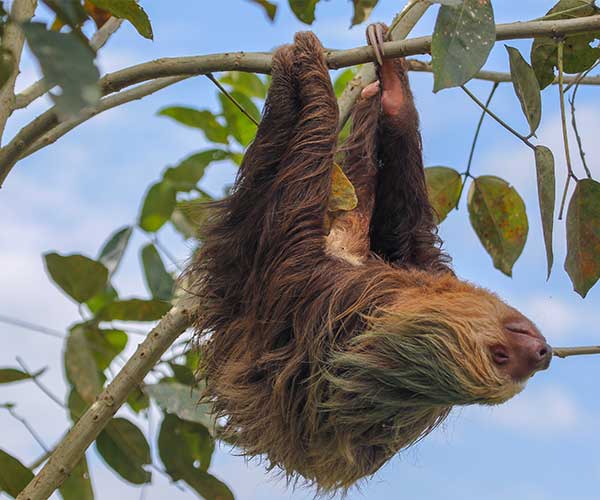 Toucan
Toucans are some of the oddest looking birds on the planet. With their giant curved beaks and relatively small body size, you might think they will topple off the trees. Costa Rica is home to six species of toucans, including the keel-billed variety which are what most people might think of when they picture the unusual bird. With their brightly coloured bills and necks, they stand out against the rainforest landscape and are relatively easy to spot in the rainforests, even from a distance. They are found throughout Costa Rica, but are smaller in size than most people expect so if you want some really great photographs, ensure your camera has a decent lense and zoom. Toucans are omnivores, which means they mainly eat tropical fruit, seeds, berries and insects. They can also be quite social animals and normally live in small flocks of between five and seven members, and while you might see them flying all over the place in Costa Rica, they don’t migrate and live in tropical climes throughout the year.
Toucan
Toucans are some of the oddest looking birds on the planet. With their giant curved beaks and relatively small body size, you might think they will topple off the trees. Costa Rica is home to six species of toucans, including the keel-billed variety which are what most people might think of when they picture the unusual bird. With their brightly coloured bills and necks, they stand out against the rainforest landscape and are relatively easy to spot in the rainforests, even from a distance. They are found throughout Costa Rica, but are smaller in size than most people expect so if you want some really great photographs, ensure your camera has a decent lense and zoom. Toucans are omnivores, which means they mainly eat tropical fruit, seeds, berries and insects. They can also be quite social animals and normally live in small flocks of between five and seven members, and while you might see them flying all over the place in Costa Rica, they don’t migrate and live in tropical climes throughout the year.
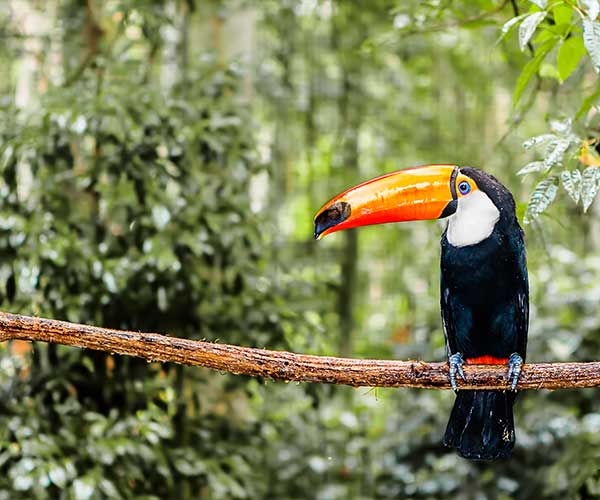 Howler Monkey
Chances are you will hear them before you see them – these feisty creatures are known for their loud howls and screams, which can be heard from up to 3 miles away. They are most commonly seen in Arenal Volcano National Park but can also be spotted in rainforests around the country. The howler monkeys are quite large in size and are covered in black fur making them distinct to many of the other monkeys found in Costa Rica. If you want to spot them, you’ll have to look up! They often build nests high in the trees and are unlikely to be seen on the ground, except when they have spied some tasty treats to snack on.
Howler Monkey
Chances are you will hear them before you see them – these feisty creatures are known for their loud howls and screams, which can be heard from up to 3 miles away. They are most commonly seen in Arenal Volcano National Park but can also be spotted in rainforests around the country. The howler monkeys are quite large in size and are covered in black fur making them distinct to many of the other monkeys found in Costa Rica. If you want to spot them, you’ll have to look up! They often build nests high in the trees and are unlikely to be seen on the ground, except when they have spied some tasty treats to snack on.
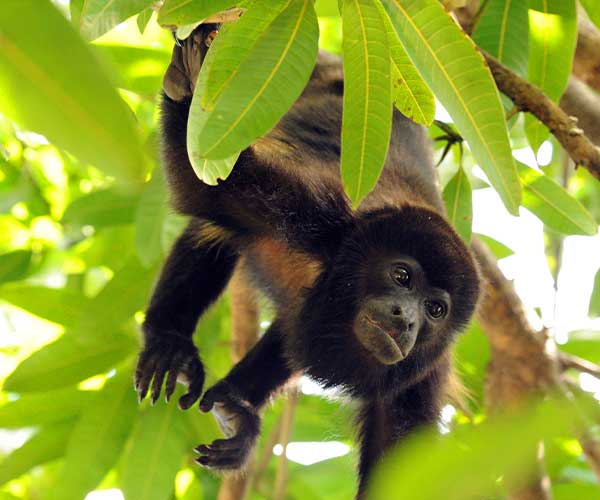 White-faced Capuchin Monkey
These cute creatures are also known as just the white-faced monkey and are commonly found in many of the national parks in Costa Rica, including Monteverde Cloud Forest and Manuel Antonio National Park. They are used to visitors and have no problem getting up close to you, often scurrying past your legs! They are also frequently spotted near the beaches in Manuel Antonio, so if you go for a dip we recommend watching your belongings or you might spot one of these cheeky animals taking off with your sunglasses.They are aptly named after their furry white face, which stands out against the rest of their black furry body. They mostly spend their days jumping between trees and foraging for food – mainly insects and plants. They are known for their excellent jumping skills so if you spot one, hang around to catch a glimpse of the distance they reach – it’s often up to nine feet! The Capuchin monkey lives in groups which can be up to 40 members, typically led by an alpha leader from each gender.
White-faced Capuchin Monkey
These cute creatures are also known as just the white-faced monkey and are commonly found in many of the national parks in Costa Rica, including Monteverde Cloud Forest and Manuel Antonio National Park. They are used to visitors and have no problem getting up close to you, often scurrying past your legs! They are also frequently spotted near the beaches in Manuel Antonio, so if you go for a dip we recommend watching your belongings or you might spot one of these cheeky animals taking off with your sunglasses.They are aptly named after their furry white face, which stands out against the rest of their black furry body. They mostly spend their days jumping between trees and foraging for food – mainly insects and plants. They are known for their excellent jumping skills so if you spot one, hang around to catch a glimpse of the distance they reach – it’s often up to nine feet! The Capuchin monkey lives in groups which can be up to 40 members, typically led by an alpha leader from each gender.
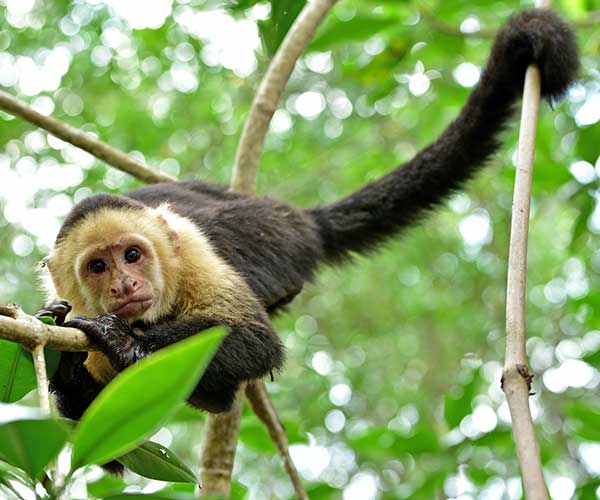 Red eyed tree frog
This brightly coloured amphibian is often plastered over Costa Rican wildlife brochures. They live in humid lowlands, often near rivers and ponds which makes the steamy Costa Rican rainforest the perfect home for these small yet vibrant creatures. The red-eyed tree frog has adapted perfectly to keep itself safe from the many predators in the county. Remaining motionless for a large part of the day, they will open their eyes wide and spread their toes to show off their startling colours. This shocks predators and gives the frog enough time to jump to safety. While they are found all over Central America, they are most prominent in Costa Rica and can often be seen in Monteverde Cloud Forest, Tortuguero National Park and Manuel Antonio National Park. They can be more difficult to spot because of their size and you’ll want a decent camera for when you are lucky enough to see one!
Red eyed tree frog
This brightly coloured amphibian is often plastered over Costa Rican wildlife brochures. They live in humid lowlands, often near rivers and ponds which makes the steamy Costa Rican rainforest the perfect home for these small yet vibrant creatures. The red-eyed tree frog has adapted perfectly to keep itself safe from the many predators in the county. Remaining motionless for a large part of the day, they will open their eyes wide and spread their toes to show off their startling colours. This shocks predators and gives the frog enough time to jump to safety. While they are found all over Central America, they are most prominent in Costa Rica and can often be seen in Monteverde Cloud Forest, Tortuguero National Park and Manuel Antonio National Park. They can be more difficult to spot because of their size and you’ll want a decent camera for when you are lucky enough to see one!
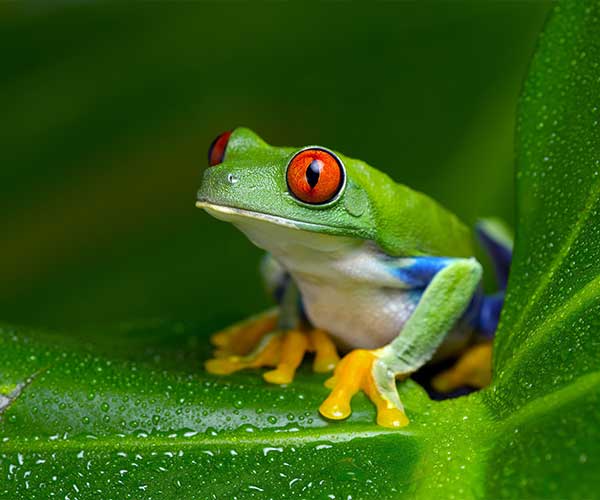 Scarlet Macaw
Native to Costa Rica, Scarlet Macaws make for the perfect wildlife photo, with their rainbow-style bright feathers contrasting against the lush green background of the rainforest. They are considered one of the most beautiful types of parrot and are often used in imagery on wildlife due to their colourful exterior. The Scarlet Macaw was once almost extinct in Costa Rica, but conservation efforts have paid off and the birds have made a great recovery, with numbers currently hovering at around 1,500. Luckily for travellers, their brightly coloured feathers don’t blend into the natural environment so they are pretty easy to spot if you’re around the right location. They can be found along the Central Pacific Coast in Costa Rica but most notably in Manuel Antonio National Park, Carara National Park and Pal Verde National Park.
Scarlet Macaw
Native to Costa Rica, Scarlet Macaws make for the perfect wildlife photo, with their rainbow-style bright feathers contrasting against the lush green background of the rainforest. They are considered one of the most beautiful types of parrot and are often used in imagery on wildlife due to their colourful exterior. The Scarlet Macaw was once almost extinct in Costa Rica, but conservation efforts have paid off and the birds have made a great recovery, with numbers currently hovering at around 1,500. Luckily for travellers, their brightly coloured feathers don’t blend into the natural environment so they are pretty easy to spot if you’re around the right location. They can be found along the Central Pacific Coast in Costa Rica but most notably in Manuel Antonio National Park, Carara National Park and Pal Verde National Park.
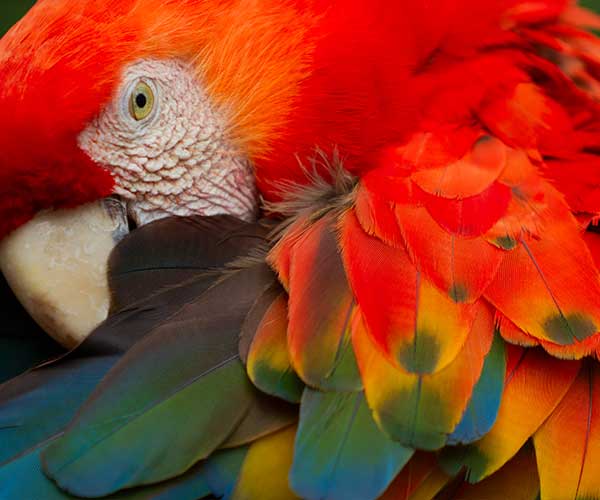 Hummingbirds
If you find yourself close to water, look out for colourful plants or flowers and you might be lucky enough to spot an equally colourful hummingbird feeding on the nectar. These small yet beautiful birds, with fluorescent feathers of green, blue and purple shades, are commonly seen in La Fortuna and Monteverde but can be spotted anywhere in Costa Rica that is close to water. The tropical country is home to around 50 types of hummingbird, with two of them being endemic to Costa Rica itself. These are the mangrove hummingbird and the coppery-headed emerald hummingbird, both with their beautifully distinctive exterior. Hummingbirds are the smallest species of bird in the world, so if you are looking for some great pictures, ensure you travel with a decent camera.
Hummingbirds
If you find yourself close to water, look out for colourful plants or flowers and you might be lucky enough to spot an equally colourful hummingbird feeding on the nectar. These small yet beautiful birds, with fluorescent feathers of green, blue and purple shades, are commonly seen in La Fortuna and Monteverde but can be spotted anywhere in Costa Rica that is close to water. The tropical country is home to around 50 types of hummingbird, with two of them being endemic to Costa Rica itself. These are the mangrove hummingbird and the coppery-headed emerald hummingbird, both with their beautifully distinctive exterior. Hummingbirds are the smallest species of bird in the world, so if you are looking for some great pictures, ensure you travel with a decent camera.
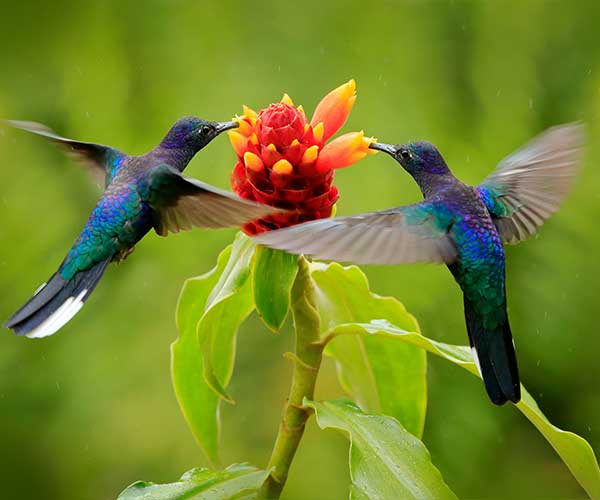 Crocodiles & Caiman
Costa Rica is home to a large population of crocodiles and caiman. Interestingly, the prehistoric looking creatures have a high tolerance to salt water and so it’s not unusual to spot them on the beaches of Costa Rica too. However, they prefer to live in rivers, swamps and lagoons and will spend most of their time on the shore warming up in the sun before lurking in the water in search of prey. For those who want the best chance at seeing them, head to Tarcoles River Bridge where hundreds roam below. You’ll often spot caiman lurking in the rivers and swamps of the national parks, waiting patiently on smaller prey along the riverbanks.
Crocodiles & Caiman
Costa Rica is home to a large population of crocodiles and caiman. Interestingly, the prehistoric looking creatures have a high tolerance to salt water and so it’s not unusual to spot them on the beaches of Costa Rica too. However, they prefer to live in rivers, swamps and lagoons and will spend most of their time on the shore warming up in the sun before lurking in the water in search of prey. For those who want the best chance at seeing them, head to Tarcoles River Bridge where hundreds roam below. You’ll often spot caiman lurking in the rivers and swamps of the national parks, waiting patiently on smaller prey along the riverbanks.
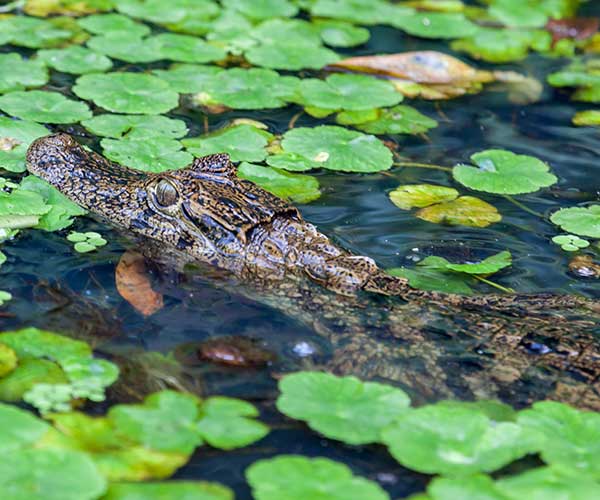 Spider Monkeys
Spider Monkeys are one of the most common animals you’ll see throughout Costa Rica. These highly social animals are named after their appearance – they have oddly long limbs and a long tail, making them very limber as they swing through the rainforest. You’ll commonly see them swinging between branches and searching for fruit and insects, occasionally dropping to the forest floor if they spot something tasty. Like many other species of mischievous monkeys, they are known to be quite vocal and will often let out a toe-curling scream if they sense any danger.
Spider Monkeys
Spider Monkeys are one of the most common animals you’ll see throughout Costa Rica. These highly social animals are named after their appearance – they have oddly long limbs and a long tail, making them very limber as they swing through the rainforest. You’ll commonly see them swinging between branches and searching for fruit and insects, occasionally dropping to the forest floor if they spot something tasty. Like many other species of mischievous monkeys, they are known to be quite vocal and will often let out a toe-curling scream if they sense any danger.
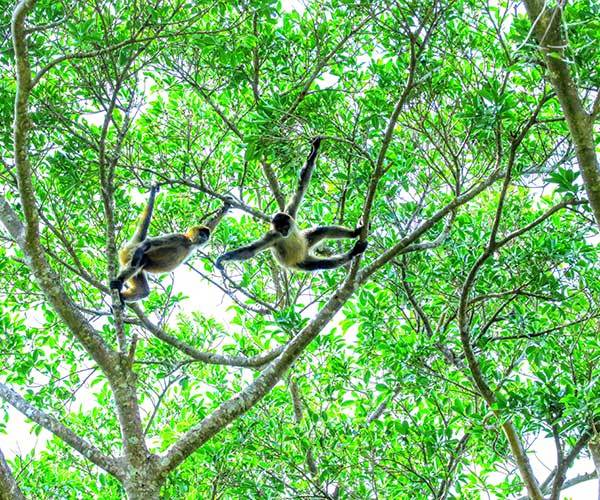 Blue Morpho Butterfly
When you’re walking through the hot and humid rainforests of Costa Rica, in search of toucans, monkeys, sloths and more, it can be easy to forget about the smaller residents of the jungle. Although small it is, the Blue Morpho Butterfly is among the largest of its species in the world with a wingspan of between five and eight inches. When you catch a glimpse of one, it really is a beautiful sight, with its neon blue wings fluttering around you. They are harder to spot than the other wildlife but can be found throughout Costa Rica and especially in Monteverde Cloud Forest.
Blue Morpho Butterfly
When you’re walking through the hot and humid rainforests of Costa Rica, in search of toucans, monkeys, sloths and more, it can be easy to forget about the smaller residents of the jungle. Although small it is, the Blue Morpho Butterfly is among the largest of its species in the world with a wingspan of between five and eight inches. When you catch a glimpse of one, it really is a beautiful sight, with its neon blue wings fluttering around you. They are harder to spot than the other wildlife but can be found throughout Costa Rica and especially in Monteverde Cloud Forest.
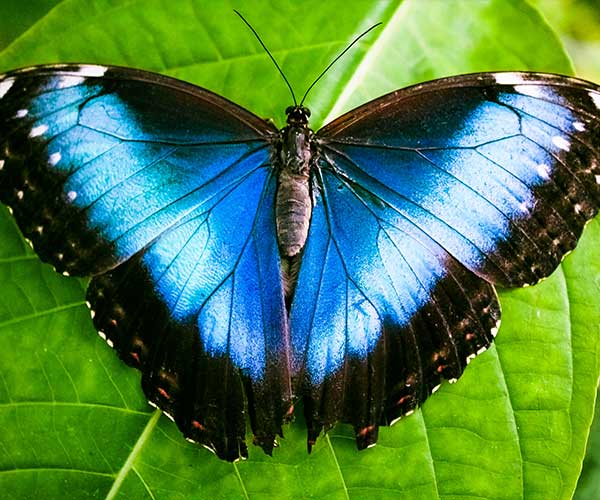 Matt Gannan is the CEO and Owner of Tucan Travel. Tucan Travel operate cultural tours in Latin America, Africa and the Middle East, Asia and Europe, as well as tailor-made holidays in Latin America, Africa and Asia.
If you would like to be a guest blogger on A Luxury Travel Blog in order to raise your profile, please contact us.
Matt Gannan is the CEO and Owner of Tucan Travel. Tucan Travel operate cultural tours in Latin America, Africa and the Middle East, Asia and Europe, as well as tailor-made holidays in Latin America, Africa and Asia.
If you would like to be a guest blogger on A Luxury Travel Blog in order to raise your profile, please contact us.Did you enjoy this article?
Receive similar content direct to your inbox.

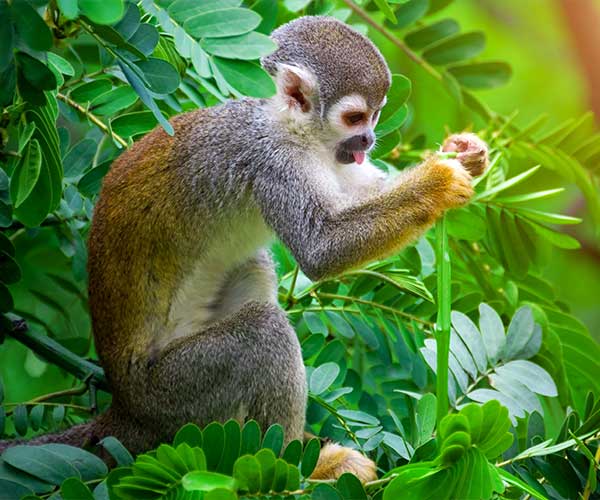

One of my friends is obsessed with the study of dragonflies and butterflies. Actually, he’s travelled the world in pursuit of his hobby, and he’s even had academic papers published on his research. He visited Costa Rica last year, and even he was impressed by the butterflies he saw. I’m sure that he probably ticked off the Blue Morpho Butterfly very early on. He wouldn’t have let that one escape him!
Hi Graham,
What a wonderful hobby that would bring you all over the world! We are yet to meet someone who isn’t impressed by the wildlife of Costa Rica.
All the best
There are some amazing stats in this piece. It is such an achievement that 25% of the country is protected. Let’s hope that those nature reserves can preserve that great diversity of species.
Totally agree. Costa Rica is taking conservation so much more seriously than most other countries. 58 wildlife refuges, 32 protected zones and 15 wetlands shows what can be done. If only the rest of the world had followed their example then we wouldn’t have so many worries about the extinction of species.
Hi Tom and Suzy,
Totally agree, Costa Rica is leading the way in conservation and sustainability. We just need the rest of the world to follow suit and protect our amazing wildlife and nature.
All the best
Top notch wildlife photography, so perfect that we think that it was effortless. But how long did the photographer spend researching were to get the best shot? And then how long did he have to wait to get perfection?
Hi Craig,
Probably a lot longer than we think! The bigger animals are easier to spot but it takes a lot of patience to get those amazing images of frogs and butterflies.
All the best
Awesome info on the animals in Costa Rica! I didn’t realize the Blue Morpho Butterflies could be seen here! I have only seen them in captivity at butterfly houses. Beautiful photos! I’d love to see a Spider Monkey!
Cheers! Sherry
Hi Sherry,
Costa Rica is so full of wildlife that it’s hard to believe until you see it!
Hopefully one day you’ll spot a Spider Monkey on your adventures :)
All the best
What a beautiful picture of the two hummingbirds!
All of this colour brightened up my Friday morning commute through the dark and drizzle.
After reading this I feel inspired to go to Costa Rica as soon as I can!
Hi Zoe,
Costa Rica is definitely full of colour! I hope you manage to get out there soon – it is such an adventure.
All the best
Aww I love sloths, so unusual and weird, but in a good way! They used to scare me when I was little, embarrassing as that is to admit. They seem to have become quite popular in modern culture at the moment and ‘fashionable’, if that’s the right word. I’m seeing sloths on mugs and notebooks and cushions and all sorts. It would be far better to see them up close. I saw a documentary that covered howler monkeys, they’re amazing! Very loud and quite surprising that such sounds can come from such small cute little creatures. I also didn’t realise there were so many species of hummingbirds. If 50 can be found in Costa Rica, I wonder how many more there are worldwide? I’d love to go to Costa Rica one day, and as you say taking a good camera is a must.
It’s fantastic to see these beautiful animals still being able to roam free in the wilds. It is a testament to Costa Rica’s efforts to keep most of its land preserved, with a fourth of the country still inhabited and protected territory. It also makes we wonder what still undiscovered creatures still lurk in their lands. It’s a fascinating idea to entertain especially in today’s modern world where people and technology have begun encroaching on these animals’ habitats.
Hi Danielle,
Thank you for the comment. Costa Rica is most definitely a world leader in conservation. I like to think there are lots of undiscovered animals still out there!
All the best
These animals look amazing. However, I’d be very careful around that red eyed tree frog. I’ve heard that colorful frogs tend to be poisonous, so I’d stay away. Or perhaps take a photo from a distance. I haven’t seen a toucan yet, so it’s something I want to see someday. I wonder if Costa Rica also has the toucan with the colorful beak. Should be interesting.
Hi
I really want to visit costa rica and as its an amzing place, there are endless options available for package holidays. However, one of the biggest reasons I am going is to see as many insects as possible but it is hard to get information on rainforest tours aimed at insect and spider hunting. Does anyone know of anything like this in costa rica. I would love to get off the tourist trails and get into the heart of the rain forest. Any help would be hugely appreciated
Costa Rica has such a wonderful array of wildlife! My favorite has to be the sloth. Such an ungainly but lovely creature!!
Is there a best time of year to visit Costa Rica for the wildlife?
Thanks
Gemma
Yes… During good weather! During the dry season which is mid-December-April. A quick google search can give you more information on this question:)
Wonderful post! Would love to see a similar list for Galapagos…
OMG YES! I stayed in Costa Rica for almost a month around 4 years ago and it is just as you say, I never once got out of my way and still got to see plenty of howling and spider monkeys (one of them did still food from me) and a Toucan! I never got to see a Sloth though, perhaps a reason to go back… Thank you for your post!
Yeah, Costa Rica is really a beautiful place. Last year we visited costa Rica for a short golf tournament. After the competition of the tournament, we stayed there to enjoy the beauty of costa Rica and see the different animals there. thanks for providing broad information about Costa Rica next time I will enjoy it in a different way.
Butterflies everywhere! Costa Rica’s abundant wildlife is truly magical. Like nothing I had seen before. A reason to go back over and over again, or even to stay for good? haha been considering it
There is no country like Costa Rica. It is truly captivating and it had this something about it that simply makes you feel welcome, and wish to stay.
Hello Matt,
Great Article! Thank you so much for sharing these top 10 animals to spot in Costa Rica. I am definitely gonna visit costa rica one day. Keep up the good work…
Cheers,
Abhay
The beauty of it is that you don’t necessarily have to go far to find them, many people simply walk out of their hotel and come face to face with fascinating creatures of all sorts.